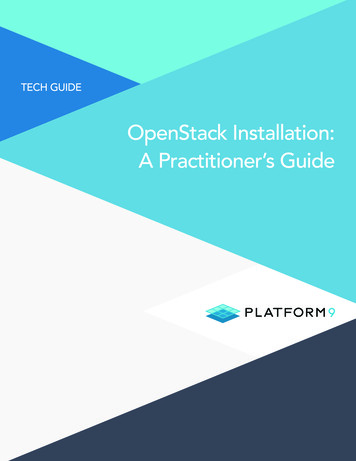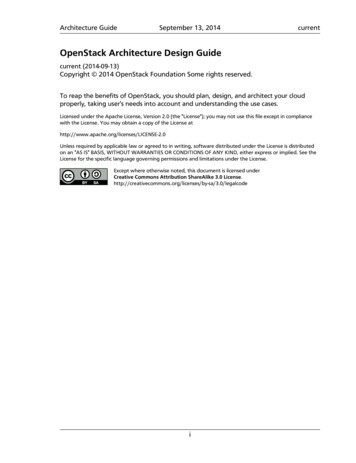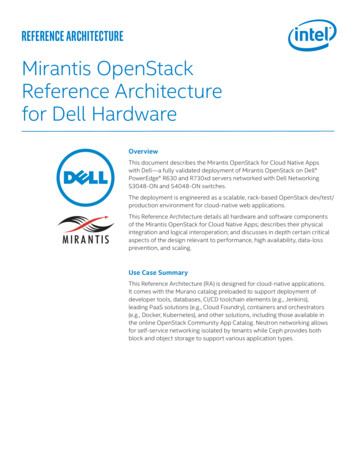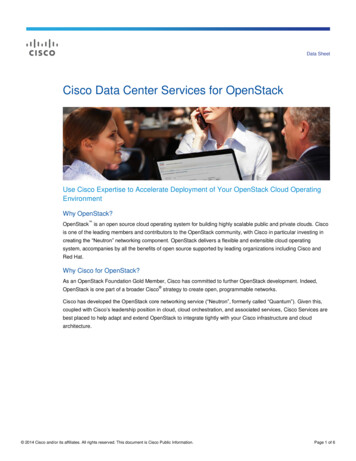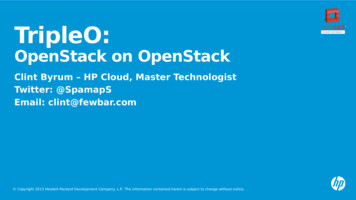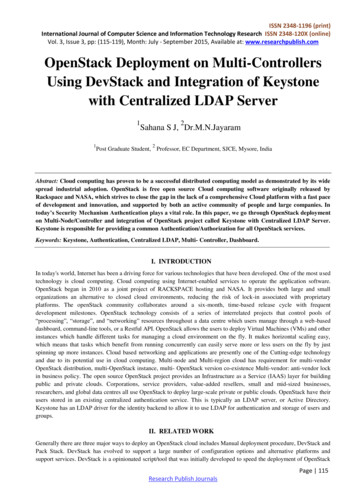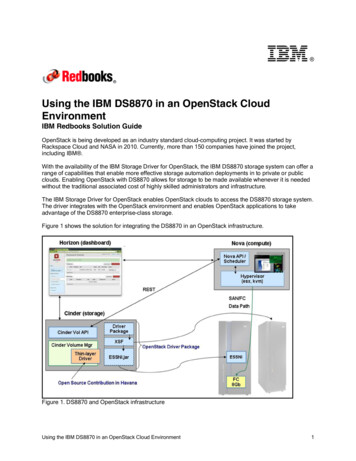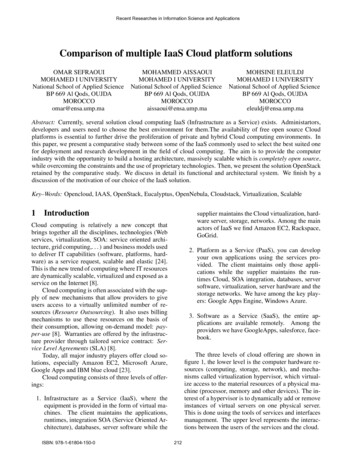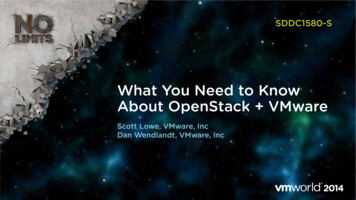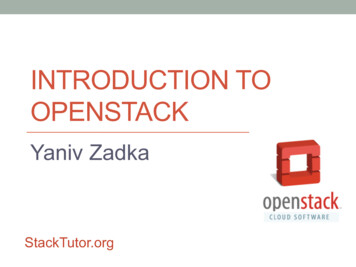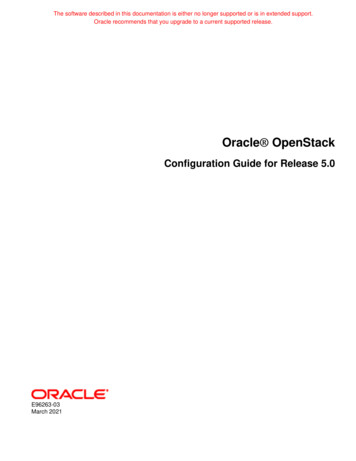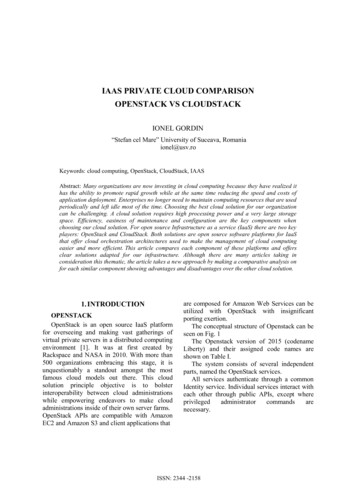
Transcription
IAAS PRIVATE CLOUD COMPARISONOPENSTACK VS CLOUDSTACKIONEL GORDIN“Stefan cel Mare” University of Suceava, Romaniaionel@usv.roKeywords: cloud computing, OpenStack, CloudStack, IAASAbstract: Many organizations are now investing in cloud computing because they have realized ithas the ability to promote rapid growth while at the same time reducing the speed and costs ofapplication deployment. Enterprises no longer need to maintain computing resources that are usedperiodically and left idle most of the time. Choosing the best cloud solution for our organizationcan be challenging. A cloud solution requires high processing power and a very large storagespace. Efficiency, easiness of maintenance and configuration are the key components whenchoosing our cloud solution. For open source Infrastructure as a service (IaaS) there are two keyplayers: OpenStack and CloudStack. Both solutions are open source software platforms for IaaSthat offer cloud orchestration architectures used to make the management of cloud computingeasier and more efficient. This article compares each component of these platforms and offersclear solutions adapted for our infrastructure. Although there are many articles taking inconsideration this thematic, the article takes a new approach by making a comparative analysis onfor each similar component showing advantages and disadvantages over the other cloud solution.1. INTRODUCTIONOPENSTACKOpenStack is an open source IaaS platformfor overseeing and making vast gatherings ofvirtual private servers in a distributed computingenvironment [1]. It was at first created byRackspace and NASA in 2010. With more than500 organizations embracing this stage, it isunquestionably a standout amongst the mostfamous cloud models out there. This cloudsolution principle objective is to bolsterinteroperability between cloud administrationswhile empowering endeavors to make cloudadministrations inside of their own server farms.OpenStack APIs are compatible with AmazonEC2 and Amazon S3 and client applications thatare composed for Amazon Web Services can beutilized with OpenStack with insignificantporting exertion.The conceptual structure of Openstack can beseen on Fig. 1The Openstack version of 2015 (codenameLiberty) and their assigned code names areshown on Table I.The system consists of several independentparts, named the OpenStack services.All services authenticate through a commonIdentity service. Individual services interact witheach other through public APIs, except SSN: 2344 -2158
18 UNIVERSITY OF PITESTI SCIENTIFIC BULLETIN : ELECTRONICS AND COMPUTERS SCIENCE, Vol.16, Issue 1, 2016Fig. 1 OpenStack - Conceptual architecture [1]Table 1 Openstack vs Apache Cloudstack [2]No1Component (Codename)Compute Heat)Telemetry(Ceilometer)10Database (Trove)11Elastic Map eTenantCloudMessaging(Zaqar)Sared File SystemService 41516Short descriptionFundamental IAAS part. Hypervisorsupheld: Xen, KVM, Hyper-V,VMwareDiscovery, enlistment, and deliverydelivery services for disk and serverimagesScalable redundant storage systemGraphical interface to access,provision, and automate cloud-basedresourceProvides a central registry of usersmapped to the OpenStack servicesthey can accessFramework for overseeing systemsand IP addresesPersistent block-level storage systemfor use with OpenStack computeinstancesManages multiple composite cloudapplications using templatesProvides a Single Point Of Contactfor charging frameworks, providindall details necessary to set upcustomer charging, over all presentand future OpenStack componentsDatabase-as-a-serviceprovisioning relational andnonrelational database engineQuick provision for Hadoop clustersby specifying necessary parametersProvisions bare metal machinesinstead of virtual machinesMulti-tenant cloud messaging servicefor Web developersAPI for managing shares in a vendoragnostic frameworkDNS as a ServiceREST API intended for the protectedstorage,provisioningandadministration of secretsAPACHE CLOUDSTACKCloudStack is quickly gaining oped by Cloud.com on 2010, CloudStackwas purchased by Citrix then later on releasedinto the Apache Incubator program. It is nowgoverned by the Apache Software Foundation(ASF). Since the Apache transition, othervendors have also joined the effort by enhancingand adding more capabilities to the coresoftware. On 2013, CloudStack graduated fromApache Incubator and became a Top-LevelProject (TLP) of Apache Software Foundation.The first stable (maintenance) release aftergraduation is version 4.0.2. [3] [4]Today CloudStack is a project built around acommittee of developers and a VP/Chair. Eventhough the project has a smaller community thanOpenStack, it is a project that is commerciallysupported its main contributor, Citrix.Resources within the cloud are managed asfollows: Regions: Grouping cloud resources intogeographic regions and managingthem with one or multiple servers. Zones: A zone is structured like adatacenter. A zone is composed fromone or more pods and must includealso a secondary data storage. Pods: Physically is the equivalent of a datarack that includes at least a layer-2switch and one or multiple clusters. Clusters: Can be identified with one or morehosts that includes also primarystorage.
IONEL GORDINIAAS PRIVATE CLOUD COMPARISON OPENSTACK VS CLOUDSTACK Host: A single server as part of a cluster.Usually the host is the hypervisor. Primary Storage: The storage resource usedby a single cluster mainly forrunning the operating system. Thistype of storage usually is muchfaster than the other types of storageused because of higher RPM harddrives or SSD hard drives. Secondary Storage: A high capacity storageresource which stores usually disk images,OS ISO files, etc.19CloudStack structure is represented on Fig. 2.Fig. 2 Cloudstack cloud infrastructure overview [5]Fig. 3 CloudStack cloud platform - Conceptual architectureCloudStack includes multiple types ofnetworking that fall into two groups:1. Basic: Single layer-2 network. Here the guestisolation is made at layer-3 using thehypervisors bridge. AWS (Amazon WebServices) uses also this type ofnetworking.2. Advanced: Layer-2 network isolated by usingVLANs, and/or SDN technologies likeas Nicira NVP.The CloudStack conceptual architecture isrepresented on Fig. 3.Features and functionality [5]: Works with hosts runningXenServer/XCP, KVM, Hyper-V, and/orVMware ESXi with vSphere Provides a friendly Web-baseduser interface for managing the cloud Provides API’s for controllingthe cloud Provides an Amazon S3/EC2compatible API Manages storage for instancesrunning on the hypervisors (primarystorage) as well as templates, snapshots,and ISO images (secondary storage) Orchestrates network servicesfrom the data link layer (L2) to someapplication layer (L7) services, such asDHCP, NAT, firewall, VPN, and so on Accounting of network, compute,and storage resources Multi-tenancy/account separation User management
20 UNIVERSITY OF PITESTI SCIENTIFIC BULLETIN : ELECTRONICS AND COMPUTERS SCIENCE, Vol.16, Issue 1, 20162. OPENSTACK ARCHITECTURECOMPUTEOpenStack’s compute layer is managed byNova project. Nova manage and automate poolsof computer resources and it can work withmany available virtualization technologies,respectively bare metal and high-performancecomputing (HPC) configurations.The architecture supports XenServer/KVM,VMware, LXC and Hyper-V.BLOCK STORAGEBlock storage is managed by Cinder projectand it is having a separate management processand corresponding API. Cinder manages theprovisioning of volumes and communication ofthe volume location to the compute project. Itcan integrateIt can integrate directly with many back-endsystems and supports as well several protocolimplementations. It is recommended to set upone Cinder management server per storage backend. The most recent OpenStack variants permitsarrangement of simultaneous back-ends throughone management server.Based upon utilized variant of OpenStack,and the wanted networking model, networkingadministration is done through either the Novasystem framework or the Neutron project. Thispart of the framework of the system routes trafficthrough the networking management nodes.The Nova networking project uses asimplified system of networking functions whileNeutron offers more advanced capabilities andincludes also plugins to support externalapplications. Neutron is supporting mainly KVMand is having constrained backing for differenthypervisors.The OpenStack interface, part of the Horizonproject, consolidates a few APIs from differentsub-projects into a single web interface.It is another administration process runningindependently from the already mentionedsystems, and must be configured to communicatewith each of other frameworks.This interface permits users to have a friendlyenvironment that allows access to all of cloudresources.SYSTEM USAGEThe Ceilometer sub-project is in charge ofgathering utilization data and for making aninterpretation of it into consumable information.It is a new project that is not completelyincorporated into the other sub-projects. Somesub-projects have been coordinated withCeilometer and offers information through acommon event bus, in this manner eliminatingthe requirement for intermittent data surveying.AUTHENTICATION/AUTHORIZATIONThis component is part of the Keystone subproject and is in charge of identity verificationfor the entire cloud environment. It is alsoconfigured as a separate set of managementprocess and APIs. Keystone uses forauthentication RBAC (Role Based AccessControl) permission scheme.3. CLOUDSTACK ARCHITECTUREOBJECT STORAGEOpenStack utilizes object storage forresources that aren't required for typical VMoperation. Swift project is the administrator forobject storage. Glance project is in charge oftemplate management. Each of these systemshave their own administration process and APIs.The Swift sub-project it is regularly utilizedoutside of a full OpenStack deployment toprovide replicated object storage for third partycloud providers (ex. Amazon S3)COMPUTEThe compute segment of the general design isthe Infrastructure-as-a-Service (IaaS) foundation[6].The compute layer's sole intention is to give arunning virtual machine. Each compute node ismanaged through the center administrationserver and supports numerous hypervisors andvirtualization platforms, including XenServer,vSphere, KVM and Hyper-V.It influences the local abilities of thehypervisor and is persistently adding moreintegration for all hypervisors.CloudStack has added recently support forVMware vMotion and vStorage Motion with thegoal of handling enterprise workloads.USER INTERFACEBLOCK STORAGE
IONEL GORDINIAAS PRIVATE CLOUD COMPARISON OPENSTACK VS CLOUDSTACKThemanagementserverkeepscommunication with the hypervisor in order toprovision volume resources and utilizes theprotocols supported by it to have access to all ofits resources. The latest cloud versions permitnativestorageareanetwork(SAN)communication from the management server tofacilitate provisioning, snapshots and thinprovisioning.This allows more advancedcapabilities of the back-end SAN to beleveraged. The block storage administration isconfigured so the management server is notinvolved in the block level operations. The blockstorage it is only used to manage volumes.CLOUD NETWORKINGNetworking is essential to provide bestperformance for cloud environment. ThroughCloudStack, networking is organized utilizing amix of the center administration and a virtualmachine (VM) application. This is deployed bythe administration server automatically andservices individual customer networks. There aretwo essential methods of network administration:Basic (AWS style) layer-3 and g likewise features custom networkservice offerings. This permits cloud managers toadapt the cloud networking to meet customerneeds including external load balancing andfirewall integration and also custom CIDR, VPNconnection. A VM application provides allcustomers enhanced network functionalitywithout extra administration servers to configureand maintain. This configuration givesadaptability in making multi-level isolatednetworks to support n-level enterpriseapplications and site-to-site VPN to existingnetworks and resources.SECONDARY STORAGESecondary storage was intended to storetemplates, snapshots and ISOs. It is coordinatedthrough a mix of the core management serverand a VM application deployed afterwardsanalyzed by an external process and converted tothe desired format.AUTHENTICATION/AUTHORIZATIONCloudStack system features authenticationand authorization in the core management server.Additionally, there is available the option to21integrate with LDAP and Active Directory aspart of the core management server.This type of architecture layer includesseveral levels of access and nesting to create ahierarchy of resource pools.Each component of OpenStack andCloudStack have been analyzed and compared indetail. The results are synthesized on Table 2.4. CONCLUSIONCloudStack was designed as a singular systemthat operates in a cohesive manner. Allcomponents are working together and operatefrom a single unified core with a centraldatabase.CloudStack includes distributed managementservers through the various VM appliances.These servers are completely automated by thecore management. The cloud administratordoesn’t have to separately administer thesecomponents.The advantage of having a single unified coreis the ability to administer everything with thehelp of a single API. OpenStack was composedfrom the earliest starting point to be acooperation of to some degree separate projects,which affected the general architecture anddesign throughout the system. This givesalternatives to the user to decide whichcomponent they want to utilize or incorporate,additionally puts more obligation on the cloudsupplier to settle on a certain design.There have additionally been occurrences ofspin off projects inside of the OpenStack project.The Cinder project is a good illustration of aspin off, as it was initially part of the Novavolume project, however was split off todecrease the general size of the Nova project andto dedicate resources to its development.CloudStack installation and configuration isrelatively straightforward, taking into accountthe complexity of the used infrastructure,whereas OpenStack is cumbersome anddisjointed to deploy and configure. On theopposite side the CloudStack management serverworks just right after the setup process.While CloudStack is a monolithic system, itsadaptability and versatility can be utilized tomeet a wide arrangement of prerequisites.OpenStack has a more modular nature, whichresults in the setup and configuration being morecomplex.
22 UNIVERSITY OF PITESTI SCIENTIFIC BULLETIN : ELECTRONICS AND COMPUTERS SCIENCE, Vol.16, Issue 1, 2016Table 2 OpenStack vs Apache CloudstackComputeBlockstorageSub-project: Nova It is functioning a as a separate management process and API Supports mainly XenSever/KVM and with limitedfunctionality for VMware and Hyper-VSub-project: Cinder It is functioning as a a separate management process and APIto organize the provisioning of volumes Communicates volume location to the compute project Managed through the core management server Supports the following hypervisors: XenServer,VMware, KVM and Hyper-V Management server communicates with the hypervisor Latest versions permits local provisioning, snapshots andthin provisioningCloudNetworking Sub-project: Neutron Provides "networking as a service" between interface devices(e.g. vNICs) managed by other Openstack services (e.g. Nova). Coordinated using a blend of central administration andvirtual machine appliances Deployed by default and manages individual customernetworksTemplates,Snapshotsand ISOs Sub-project: Swift Offers cloud storage software that permits storing andretrieving data with an API. It's built for scale, availability andconcurrency across the entire data set. Swift is ideal for storingunstructured data that can grow without bound. Template management is provided through Glance, anothersub-project Sub-project: Horizon Combines several APIs from different subprojects into asingle web user interface Known as Secondary Storage in CloudStack, it wasintended to store layouts, snapshots and ISOs Provides a bridge between end users and the storage areaUserInterface Part of the core management server application AJAX base web US Handles requests of the system for administrators andend usersSystemUsage Sub-project: Ceilometer Responsible for gathering usage event data and for making aninterpretation of it into usable information Core management server gathers events related toresources Usage and Events Such as beginning, halting orchanging a VMAuthentication/Authorization Sub-project: Keystone Identity service for authentication (authN) and high-levelauthorization (authZ). It currently supports token-based authNand user-service authorization. Integrates with LDAP and Active Directory Includes several levels of access that permits making ahierarchy of resources poolsCloudStack provides the functionality todeploy environments rapidly; with easy supportfor common protocols, it is possible to stand up apractical cloud in just few hours versus daysOpenStack that is more complex to install andsetup.Despite the fact that the CloudStack extendright now has less brand visibility in the cloudscene, Citrix’s commitment offers credibility tothe product and its ongoing development forservice providers.Although, the installation of OpenStack iscomplicated, it offers a more stable platform thanCloudStack and adding advanced features thatoffers is a more attractive adopted by largecorporations. [7] [8].5. REFERENCES[1] ck.org/. [Accessed 29 03 2016].[2] a.org/wiki/OpenStack. [Accessed29 03 2016].[3] SalamIsmaeel,"OpenSourceCloudManagement Platforms: A Review," in 2015 IEEE2nd International Conference on Cyber Security andCloud Computing, New York,NY, 2015.[4] "Apache CloudStack," [Online]. Available:https://en.wikipedia.org/wiki/Apache CloudStack.[Accessed 29 03 2016].[5] "Apache CloudStack - Open source ack.apache.org/. [Accessed 29 032016].[6] B. Arshdeep and M. Vijay, "Cloud Computing: AHands-On Approach," CreateSpace IndependentPublishing Platform, 2013, pp. 86-88.[7] "A Comparative Study of OpenStack andCloudStack," in 2015 Fifth International Conferenceon Advances in Computing and Communications,Kochi, India, 2015.[8] AaronParadowski,"BenchmarkingthePerformance of OpenStack and CloudStack," in nt-Oriented Real-Time DistributedComputing, Reno, NV.
OPENSTACK VS CLOUDSTACK IONEL GORDIN "Stefan cel Mare" University of Suceava, Romania ionel@usv.ro Keywords: cloud computing, OpenStack, CloudStack, IAAS Abstract: Many organizations are now investing in cloud computing because they have realized it has the ability to promote rapid growth while at the same time reducing the speed and costs of
